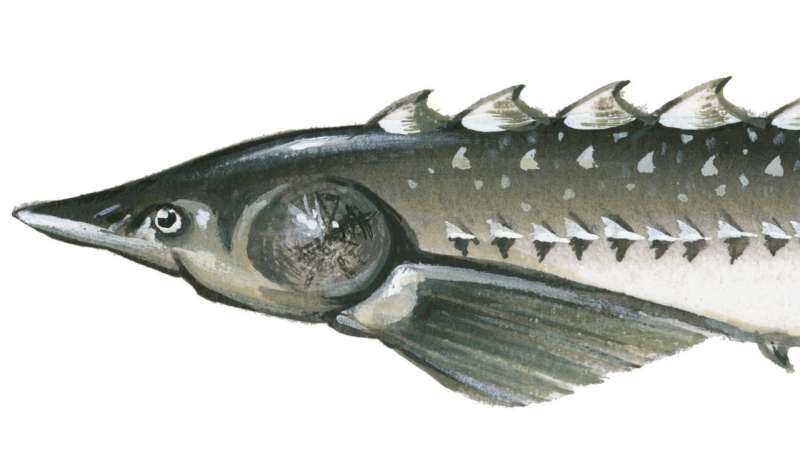The Atlantic sturgeon's sojourn

Atlantic sturgeon that summer in Maine's Penobscot River estuary can be found in the fall and winter in waters as far away as Nova Scotia and New York City, according to a seven-year University of Maine study of the fish that is one of the planet's living fossils.
Results of the study are helping identify the fish's critical habitats, and inform management decisions concerning the species.
Adult Atlantic sturgeon (Acipenser oxyrinchus oxyrinchus) have been cruising the rivers and coastline of what is now Maine for millions of years. Despite their size—they can grow to be more than 13 feet long and weigh over 600 pounds—Atlantic sturgeon are elusive creatures. And their numbers have dwindled.
At one time, the anadromous fish were abundant in waters spanning the East Coast of North America, from Labrador, Canada to Florida. But an extensive caviar fishery, industrial activity and damming along the rivers crucial for the fish's spawning and summer foraging brought the population to record lows.
Currently, Atlantic sturgeon are listed as threatened in the Gulf of Maine and endangered throughout the rest of their U.S. range.
A UMaine research team led by Gayle Zydlewski, associate professor in the School of Marine Sciences, is working to shed light on the sturgeon's complex life history to help inform conservation strategies. For seven years, the researchers have focused on the sturgeon's estuary habitats and where they go when they leave them. They recently published some of their findings in the journal Marine and Coastal Fisheries.
During the course of the study, which focused primarily on young adult (subadult) sturgeon, the researchers surgically implanted acoustic transmitters in a number of fish caught in the Penobscot River estuary and tracked their movements using a regionwide network of underwater receivers. The receivers were placed strategically throughout an almost 30 mile stretch of the Penobscot River estuary and across key passages in Penobscot Bay. Others receivers were located in the marine waters both within and outside the Gulf of Maine.
The researchers found that during the summer months, subadult sturgeon congregate in a narrow 3 mile stretch of the Penobscot estuary, most likely to forage on the area's abundant marine worms. Nearly all of the tagged sturgeon returned to this specific location for multiple years.
In the fall, the fish migrate to the Gulf of Maine. While the majority of the fish seem to remain in the waters off the coast, some strayed quite far from their summer Maine homes. A few of the sturgeon from the Penobscot estuary were detected in waters as far away as the Bay of Fundy in Nova Scotia and the Hudson River in New York.
The study identifies the Penobscot River estuary as a critically important place for Maine's subadult sturgeon population and the discovery of extensive migration patterns emphasize the need for future conservation and management strategies that can span regional subpopulations and international boundaries.
More information: Gail S. Wippelhauser et al. Movements of Atlantic Sturgeon of the Gulf of Maine Inside and Outside of the Geographically Defined Distinct Population Segment, Marine and Coastal Fisheries (2017). DOI: 10.1080/19425120.2016.1271845
Provided by University of Maine


















